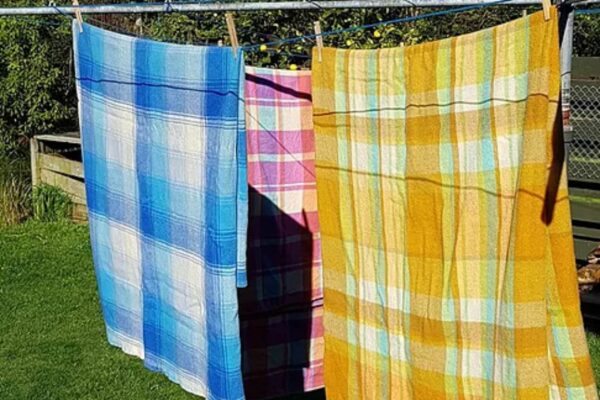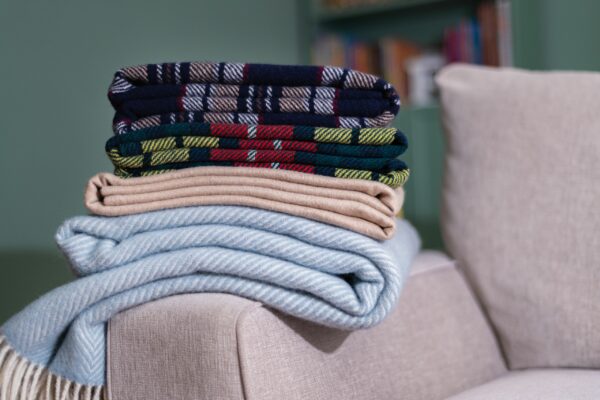How to Wash Woollen Blankets

Big woollen blankets are a mainstay in most kiwi homes in the winter months. All warm and snuggly, nothing beats wool. Natural fibres are the best choice for bedding options; they look great, they are breathable and they are durable giving you years and years of great rest! (And as a side note, from a safety point of view, wool doesn’t easily burn and is therefore safer than man-made synthetic fibre blankets which burn very easily).
When it comes to laundering bedding, because their sheer size and weight it really can be a task! But with these tips you will find they are easy to look after.
Taking care of your woollen blankets
Here is the perfect method for washing large woollen blankets. These are best washed at the end of the winter season just before they are packed away for the summer months. But this is also a great method at any time that deep washing is needed. This method uses cleaning agents that have been traditionally used in the washing of wool. Borax has long been known as a wonderful gentle cleaner for delicate garments. Soap will lift away stains and grime without being harsh. Vinegar is the perfect non-toxic fabric conditioner to leave your blankets soft and fresh.

What you’ll need to wash your woollen blankets
- Time – allow 3 x 20 minute periods
- A bucket, basket or bag that is waterproof
- ½ cup Figgy Strong white vinegar
- 1 cup of Borax
- Figgy bar soap
- Woollen blankets (up to three)
Here’s a time saving tip: If you find a blanket with a small mark on it that is otherwise clean, consider doing a spot wash only. This will save you the task of a full wash and may be all the laundering that is required! (Instructions for spot washing are at the end)
How to wash your woollen blankets
- 1. The bath tub is the best place to wash woollen blankets, this is because the space allows the blankets to soak and spread out. Cramped washing conditions can mean some parts of an item don’t get washed very well. The other great thing about using the bath is you side step all of the typical problems with machine washing like some parts of the blanket being overly agitated leading to pilling, felting or holes. If you don’t have a bath, don’t despair! You can use your washing machine if it has a woollens cycle – just be very aware of how full the machine is and do one blanket at a time.
2. The first thing you need to do is pick a good (weather) day. Because after your blanket has been washed, you’ll want to put your blanket outside to air dry. More about this towards the end.
3. A regular sized bath tub is large enough to wash 2-3 blankets, maybe four at a stretch if the blankets are singles. Remember that they are big and bulky, and heavy when wet. So while it might seem like a great and efficient thing to wash them all at once – more often two blankets at a time is just easier.
4. Look your blanket over for any stains or marks. We are going to treat these first. Old stains may not shift, they have essentially dyed the fabric fibres. But some old stains are ripe for the picking and respond really well to the attention!! Wet up the area of the stain and take your Figgy bar soap and work up a small amount of lather, work the bubbles into the stain area gently. You do not want to rub at all – this could felt the wool. Allow this to sit for 10-15 mins, during this time go ahead and run the bath.
5. The water for soaking the blankets should be ‘blood temp’ or tepid – this is luke warm or around 35 degrees. Water that is cool will not aid in the cleaning and water too hot will damage the wool. You want the bath around 1/3 full. Before you finish filling, add the borax. Swoosh it around with your hands to mix it in and dissolve – sometimes it can be stubborn about this. Rinse your hands as borax can be drying. Just before you turn the water off, hold the bar of soap under the tap for about a minute to create a slightly soapy borax mix. Add your blankets.
6. Gently submerge, pushing them under until they are wet. Space them out so they are all getting the same amount of room. Leave them to soak for 20-60 minutes. A shorter soak time will work for blankets that are washed more often and really just need a freshen up. 60 minutes will suit a blanket that needs a deeper clean. Part way through the soak, give the blankets a slow swoosh to gently agitate. Check on any stains, suds again if needed. You may find some brightly coloured blankets will release a small amount of colour. This is common, and will not affect the blankets from colour transfer.
7. After the soak is finished, let the water out. Fill the bath again (or twice) with tepid water to rinse the blanket. Fill a final time with enough cool water to cover and add the vinegar. Again gently swoosh and move the blankets around so they all are bathed in this vinegar rinse. The vinegar acts as a neutralizing agent for the borax and soap. The cleaning solution is alkali and the acidic vinegar will bring the blankets back to neutral and ready to be spun and hung out to dry.
8. Now for the fun bit, getting your dripping wet blanket to the washing machine to be spun. Before getting the blankets out of the tub do you best to squeeze out some water. Carry your blanket using your waterproof bucket or basket and transfer it into your washing machine. Make sure it is spread out evenly to prevent the machine getting out of balance if you have a top loader. Set it to a slow spin. Once it is finished hang it on the line or over a clothes rack. If you are using the washing line, hang it over several lines so that the heavy blanket doesn’t pull from one point and distort the shape. Another option is to lay it out on the trampoline if its clean enough – this is such a great option for flat drying woollens!
9. When it is lovely and dry, bring it inside and store it away until the weather turns cool again. A couple drops of lavender oil onto the blanket or gauze bag with cedar chips are a great way to give your blankets a lovely smell and some protection from blanket moths that sometimes like to make a nest in tucked away fluffies!
Storing your blankets until next winter
After washing and thoroughly drying your woollen blankets safely store them until next time you’ll need them. At times, moths can attack wool and leave holes. Avoiding this can be as simple as keeping your blankets in a moth proof bag or container. Alternatively you can keep cedarwood close to your woollens, cedar will repel moths, though this isn’t a 100% method. It is a far healthier method than using ‘moth ball’ that are made from toxic chemicals.
Ideas to keep your blankets smell gorgeous: Store bar soap not being used with your blankets. The essential oils fragrance will impart a delicate fragrance. Otherwise essential oil drops can be added directly to a hanky or other fabric and stored with or between your blankets. Try Rosemary, Lavender or Eucalyptus as all these are wonderful with textiles and are said to repel insects in your linen cupboard.